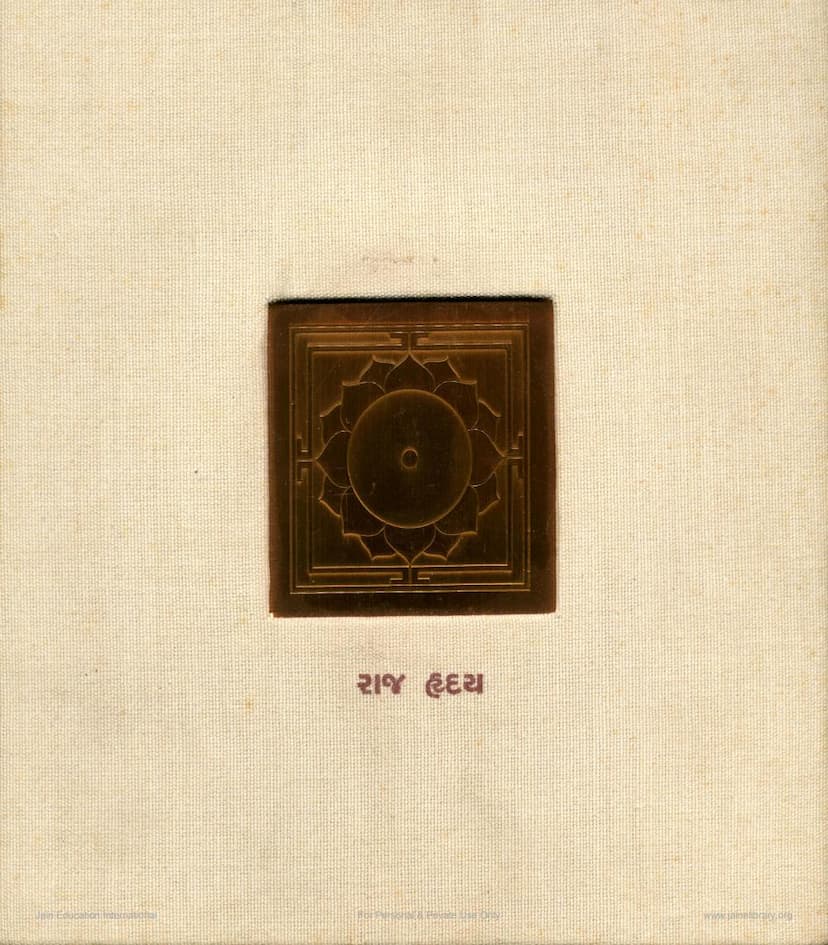Raj Hriday
Added to library: September 2, 2025

Summary
Here's a comprehensive summary of the Jain text "Raj Hriday" based on the provided pages:
Title: Raj Hriday (Heart of Raj) Author(s): Raj Saubhag Editorial Committee Publisher: Raj Saubhag Satsang Mandal Sayla
Overall Theme: "Raj Hriday" is a compilation that celebrates the profound spiritual relationship and the profound spiritual journey of two significant souls in the Jain tradition: Paramkrup<bos> Shrimad Rajchandraji and P.P. Saubhagbhai. The book focuses on their deep spiritual connection, Shrimad Rajchandraji's teachings, and the establishment of the Raj-Saubhag Ashram. It highlights the path of spiritual liberation as expounded by Lord Mahavir and revitalized by Shrimad Rajchandraji.
Key Figures and Their Significance:
- Shrimad Rajchandraji: Revered as a direct successor to Lord Mahavir, he is described as an epoch-making visionary who re-established the essence of Jain philosophy. He possessed remarkable spiritual insights from a young age, including extraordinary memory, past-life knowledge, and a deep detachment. His life was dedicated to experiencing and realizing the pure soul.
- Shri Saubhagbhai: Described as a "paramarth sakha" (spiritual companion) and a crucial guide for Shrimad Rajchandraji, Saubhagbhai played a pivotal role in Shrimadji's spiritual awakening. Their meeting in 1946 (Samvat) was a turning point, leading Shrimadji to a deeper understanding of the soul and body separation, and ultimately to the realization of pure samyag-darshan (right faith) in 1947. Saubhagbhai is portrayed as a pure, simple, and devoted soul.
The Spiritual Bond and Shrimad Rajchandraji's Letters:
- The book emphasizes the deep spiritual connection between Shrimadji and Saubhagbhai, describing it as an innate bond across lifetimes. Their profound inner connection led to a deep spiritual rapport.
- A significant portion of the book comprises letters from Shrimad Rajchandraji to Saubhagbhai. These letters are a treasure trove of spiritual guidance, introspection, and Shrimadji's personal spiritual progress. They reveal his inner struggles, his quest for spiritual realization, and his unwavering devotion.
- Shrimadji's letters express his deep admiration and reverence for Saubhagbhai, acknowledging his role as a guide and source of inspiration. He often seeks Saubhagbhai's understanding and support in his spiritual endeavors.
Key Spiritual Concepts and Teachings:
- Pure Samyag-Darshan: The book underscores that true religion begins with the realization of the pure soul and correct perception. Saubhagbhai's influence was instrumental in Shrimadji's attainment of this state.
- The Path of Detachment (Vairagya): Shrimadji's life exemplified profound detachment from worldly possessions and activities, as he increasingly focused on his true self.
- Inner Peace Amidst External Upadhis (Attachments/Worries): The text highlights that true peace (Samadhi) is found within, even amidst external disturbances. Shrimadji's inner stillness contrasted with external activity.
- The True Nature of the Soul: The book repeatedly emphasizes the soul's eternal, formless, and immutable nature, distinct from the physical body.
- The Importance of a Living Guru: The text strongly advocates for the guidance of a living, realized soul (Sadguru) for spiritual progress, drawing parallels to how a single ray of the moon is more effective than distant stars.
- "Beej Gyan" (Seed Knowledge) and "Sudarasa" (Nectar of Knowledge): These are referred to as potent tools for spiritual realization, transmitted through the grace of a Sadguru. Saubhagbhai received this knowledge from his father and imparted it to Shrimadji, marking a crucial step in Shrimadji's spiritual journey.
- The "Atma-Siddhi Shastra": This significant scripture was authored by Shrimadji, inspired by Saubhagbhai's request for the essence of the scriptures in verse. It is considered a condensed form of the fourteen Purvas.
The Raj-Saubhag Ashram:
- Established in Sayla, Gujarat, the ashram is a testament to the spiritual legacy of Shrimadji and Saubhagbhai. It serves as a center for spiritual seekers.
- The ashram provides a serene environment conducive to self-reflection and spiritual practice, with various activities focused on self-improvement.
- It follows the teachings of Lord Mahavir as interpreted by Shrimad Rajchandraji, emphasizing a broad spiritual perspective that includes both Jain and non-Jain saints.
- The ashram is actively involved in various humanitarian and social service activities, including medical aid, education, and disaster relief, reflecting the principle of "Jan Seva Hi Prabhu Seva" (Service to humanity is service to God).
The Relationship of Shrimadji and Saubhagbhai:
- Their relationship is described as a divine union of souls, a spiritual friendship that transcended worldly considerations.
- Shrimadji held Saubhagbhai in extremely high regard, often seeking his advice and reflecting on their spiritual connection.
- Saubhagbhai's devotion to Shrimadji was absolute, leading him to fully merge his identity with Shrimadji's spiritual essence.
- The book includes numerous quotes from Shrimadji's letters, expressing his profound affection, respect, and reliance on Saubhagbhai. These quotes showcase Shrimadji's vulnerability and his deep appreciation for Saubhagbhai's presence in his life.
- Shrimadji attributed much of his spiritual progress and the attainment of "Atma-Siddhi" to Saubhagbhai's influence and grace.
Saubhagbhai's Passing and Shrimadji's Grief:
- The book details Saubhagbhai's peaceful passing in a state of spiritual absorption (Samadhi).
- Shrimadji experienced profound grief and sorrow at Saubhagbhai's departure, expressing his deep sense of loss and celebrating Saubhagbhai's spiritual attainment. He recognized Saubhagbhai as a rare soul of immense spiritual caliber in this era.
Conclusion:
"Raj Hriday" serves as a devotional offering to the spiritual bond between Shrimad Rajchandraji and Saubhagbhai. It not only highlights their unique spiritual journey but also provides profound spiritual insights and guidance for seekers on the path of self-realization, emphasizing the timeless teachings of Jainism and the transformative power of true spiritual companionship.